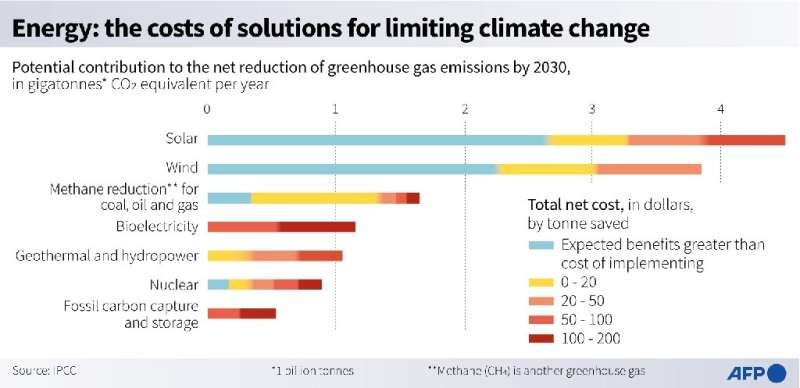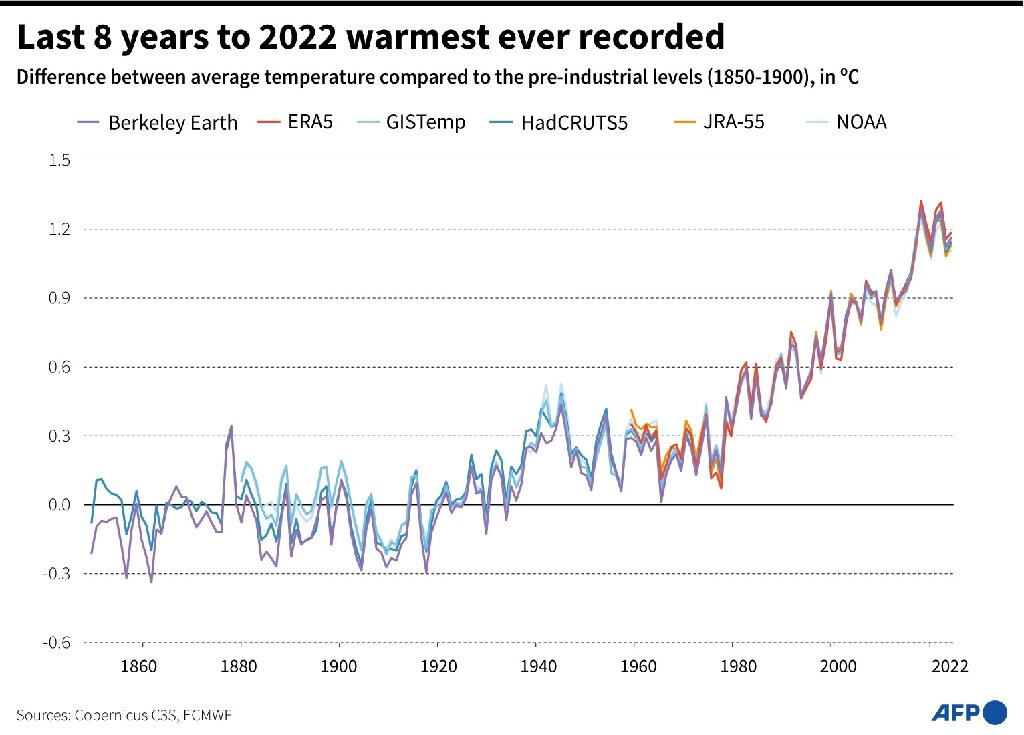|

June
06,
2023
By Marlowe Hood, with Benjamin Legendre in Bonn

Wind turbine and a coal power plant in Germany.
Banish fossil fuels, capture their emissions,
pull CO2 from thin air—diplomats in Bonn for UN-led climate talks
agree there's too much planet-warming carbon dioxide in the
atmosphere, but remain at loggerheads on the best way to reduce it.
At stake is nothing less than a liveable world: even if humanity caps
global warming at 1.5 degrees Celsius—a huge 'if'—hundreds of millions
will still confront devastating heat, drought, flooding and sea level
rise, recent studies have shown.
There are three ways to deal with the problem, intervening at
different points in the CO2 "value chain" from source to tailpipe:
stop burning fossil fuels, by far the main driver of warming; if you
do burn them, stop carbon pollution from seeping into the air; and
remove CO2 from the atmosphere once it's there.
"All technologies, all levers available need to be used," Simon Stiell,
the head of UN Climate, told AFP as the talks in Bonn opened.
"But the science is very, very clear: the fastest and most effective
way of getting us to where we need to is the phasing down and phasing
out of all fossil fuels."
Politically, an informal "high ambition" coalition including the
European Union (especially Germany) and scores of climate vulnerable
developing countries are pushing—to cite the Association of Small
Island States (AOSIS)—to "radically reduce fossil fuels now" through
policy, regulatory and economic levers.
But major oil and gas exporters, the United States and some emerging
economies are keen to shift the focus further downstream, saying the
world can reduce carbon emissions without ditching the fossil fuels
that generate them.
Persistent failure
Their standard bearer is Sultan al-Jaber, head of the Abu Dhabi
National Oil Company and—controversially—president of the COP28
climate summit to be hosted at year's end by the United Arab Emirates.

Potential and cost of energy options for reducing greenhouse gas
emissions by 2030.
The persistent failure over decades to cut carbon
emissions—currently 53 billion tons of CO2 or its equivalent per
year—has forced once marginal technologies toward centre stage.
These fall roughly into two categories that are often confused and
conflated.
"Carbon capture" refers to siphoning off concentrated CO2 from the
exhaust, or flue gas, of coal- and gas-fired power generation, as well
as heavy industrial processes.
Once isolated, the CO2 can be used to make products ("carbon capture
and utilization" or CCU), or socked away underground in depleted oil
and gas reservoirs ("carbon capture and storage" or CCS).
A crucial point: Even when CCS stores all the CO2 captured, it does
not decrease the amount in the atmosphere. But only prevent more from
entering.
Potential advantages
Carbon dioxide removal (CDR) techniques, however, do result in a net
reduction in atmospheric CO2 and could, if scaled up, help lower
Earth's surface temperature when we overshoots the Paris Agreement's
1.5C threshold, as seems likely.
Worldwide, CDR captures two billion metric tons of CO2 each year,
according to the inaugural State of Carbon Dioxide Report.
More than 99.9 percent is extracted through "conventional" techniques
such as restoring and expanding CO2-absorbing forests.

Canadian boreal forest west of Quebec.
Less than 0.1 percent is removed by "novel"
means, and one in particular—direct air capture (DAC), an
energy-intensive process that chemically extracts CO2 from the air—
has attracted the most attention and investment.
It's contribution to the cause is anecdotal: today, less than 20 DAC
plants globally capture about as much CO2 in a year (10,000 tons) as
the world emits in about 10 seconds.
But once upon a time scaling solar power looked as improbable,
advocates note.
Indeed, the IEA's so-called "net zero emissions by 2050 scenario"
assumes DAC will capture 60 Mt CO2/year by 2030. The first million-ton
plant is due to come on line next year.
DAC has potential advantages, especially compared to a troubled carbon
offsets markets based on protecting or growing trees.
'Unknown risks'
Forests burn down, especially in a warming world, which makes them
less than permanent, a key criterion under UN rules.
A ton of mechanically extracted carbon stored underground is easily
measured and monitored. Not so for forest-based credits, which are
notoriously subject to cheating and dodgy accounting.
Last month Zimbabwe sent a shudder through the $2 billion offsets
market by announcing it would appropriate half of all the revenue
generated from offsets on its land, exposing another vulnerability.

Last 8 years to 2022 are the warmest ever recorded.
The
small but burgeoning DAC industry was itself thrown into turmoil last
week by a 100-page UN "information note" on which removal techniques
might be recognized under carbon market accounting rules still in the
making.
The aggressively dismissive note said "engineering-based removal
activities are technologically and economically unproven, especially
at scale, and pose unknown environmental and social risks."
Pushback was sharp, with scores of carbon removal start-ups and
several independent research groups pointing out glaring scientific
inaccuracies underlying the report.
"This tells us that there's a lot of money at stake as to which
technologies are given the green light," noted Alden Meyer, a senior
policy analyst at climate think tank E3G.
'Residual emissions'
So what's the right balance between reducing fossil fuel use and
finding ways to scrub CO2 from industrial processes and the air?
"Machine based removal is simply unlikely to work at any meaningful
scale," scientist Jonathan Foley, executive director of Project
Drawdown, which evaluates the potential of mitigation solutions, told
AFP.
"Ninety-five percent of what we need to do is cut emissions," he said.
"Five percent is carbon removal, and 90 percent of that should be
nature based removal such as ecological restoration and regenerative
agriculture."
But those ratios are not in line with the long-term national
strategies for reaching net zero emissions by 2050, according to a
recent study in Nature Climate Change.
Most wealthy countries still allow for large "residual emissions" when
they hit net zero—on average, 18 percent of current emissions—on the
assumption that technology will be available to capture and remove
them by then.
Green Play Ammonia™, Yielder® NFuel Energy.
Spokane, Washington. 99212
www.exactrix.com
509 995 1879 cell, Pacific.
exactrix@exactrix.com
|